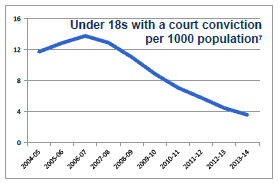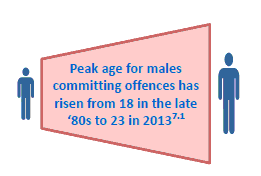Preventing offending: getting it right for children and young people
Our Youth Justice strategy for Scotland, for 2015 to 2020.
Introduction
Our vision of Scotland as the best place to grow up extends to all of our children and young people.
Scotland has a proud record of taking a holistic approach to the needs of children and young people. Where children are involved in or at risk of offending, evidence and experience tells us that we must remain committed to an integrated approach - tackling deeds while taking account of wider needs.
We know that as far as possible children and young people should be kept out of the Criminal Justice System. Where offending does take place, effective and timely interventions are needed to address that behaviour and its causes.
Progress - founded on that consistent Scottish philosophy - has been made over recent years. This has been delivered with the support of national and local partners, through the implementation of both the Preventing Offending by Young People Framework [1] and the national roll-out of the Whole System Approach in all mainland authorities. Positive alternatives, prevention and ensuring that appropriate interventions are in place where children and young people are involved in offending, are part of a broader approach to tackling inequalities and promoting social justice.
We take a child-centred, preventative approach focused on the following outcomes:
- helping ensure communities are safe from crime and disorder
- improving life chances for children and young people involved in or at risk of offending
- enabling all children and young people to be confident individuals, effective contributors, successful learners and responsible citizens
The importance of a child-centred approach to Getting It Right for Every Child ( GIRFEC) has been reaffirmed by the Children and Young People (Scotland) Act 2014 (the 2014 Act) [2] . Provisions in the 2014 Act in respect of Children's Services Plans, Named Person and Child's Plan will be critical to future arrangements in support of youth justice.
Priority themes for 2015 to 2020 are:
Advancing the Whole System Approach
Improving Life Chances
Developing Capacity and Improvement
We will continue to place real importance on partnership working, and will help increase capacity to use co-production and asset-based approaches involving children and young people building on their strengths and attributes.
In this document when we talk about a child we are referring to someone under the age of 18. This respects the definitions set out in the 2014 Act and the United Nations Convention on the Rights of the Child. Good practice indicates the principles can also apply to young people over 18, and there is a particular need for various partners and agencies to take account of their corporate parenting responsibilities.
Youth Justice in Scotland - key statistics since the 2008 'Preventing Offending by Young People' framework
Crime is at a 40 year low [3] , and offending by young people has halved since 2008-09 [4] .
 |
70% reduction in number of under 18s in custody |
 |
83% reduction in children referred to Children's Hearings System on offence |
 |
74% reduction in children appearing in court over last seven years [7] |


The Centre for Youth and Criminal Justice's paper 'Youth Justice in Scotland: Fixed in the past or fit for the future?' sets out useful contextual material and articulates a number of challenges which have informed this strategy [8] .
Contact
There is a problem
Thanks for your feedback